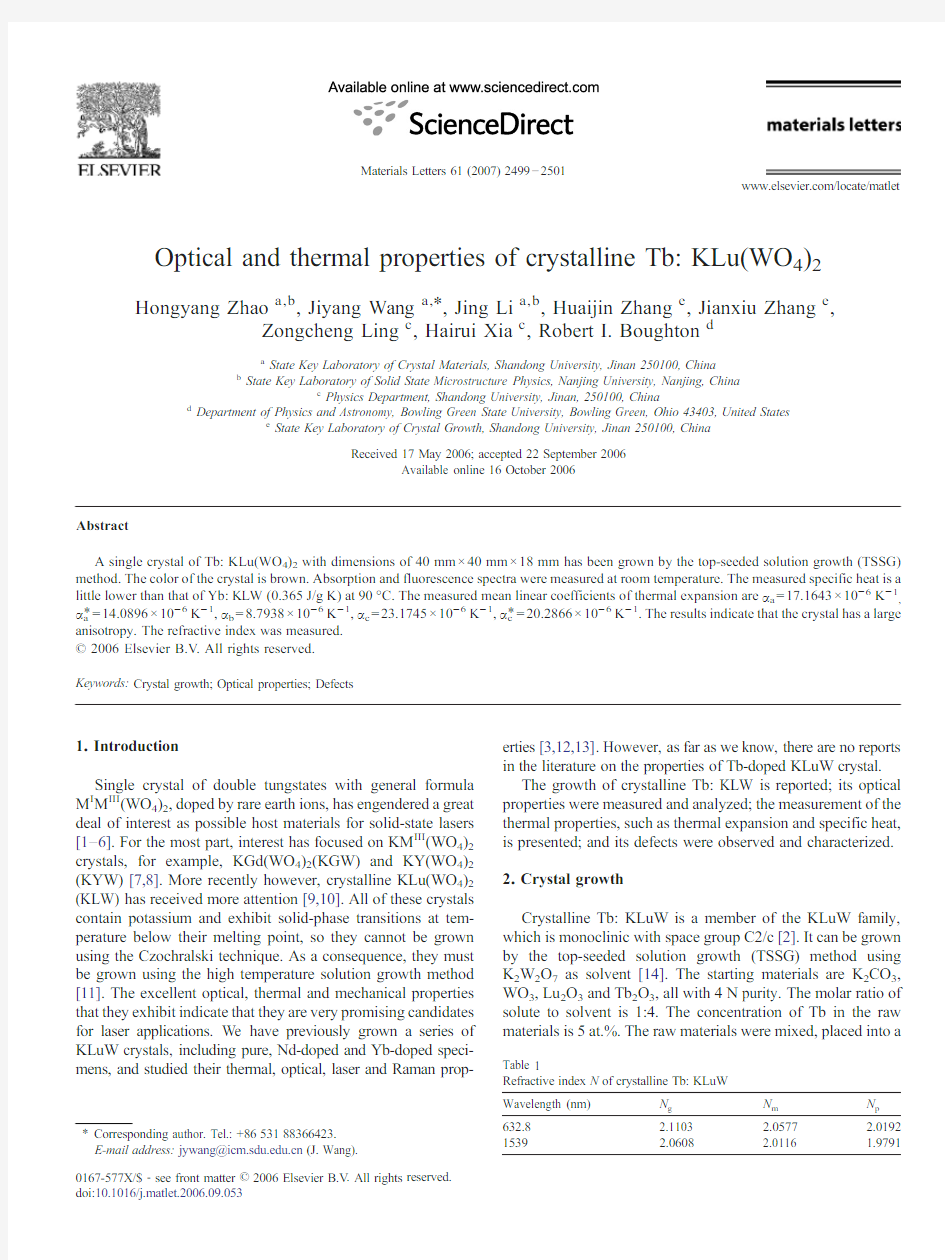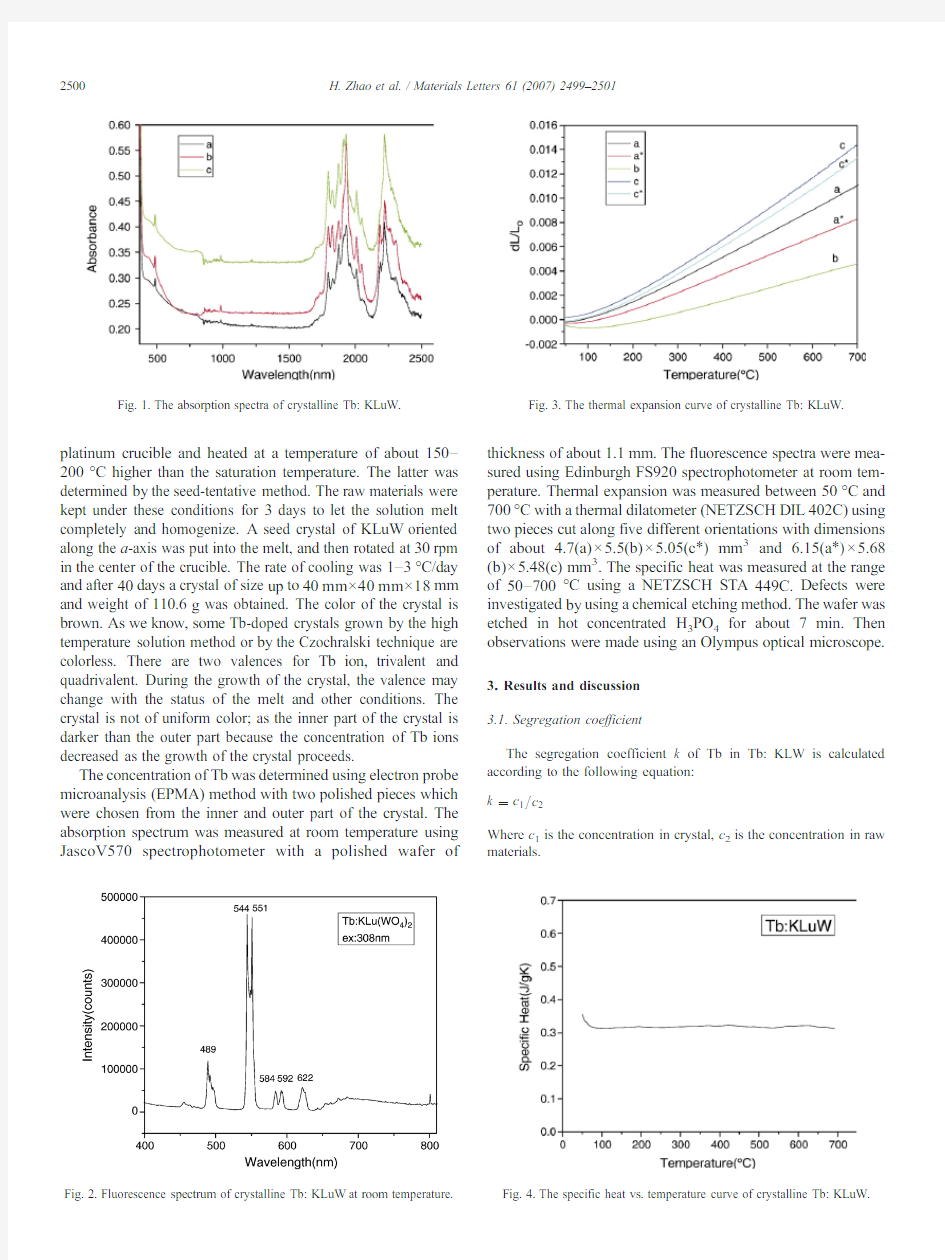

Optical and thermal properties of crystalline Tb:KLu(WO 4)2
Hongyang Zhao a,b ,Jiyang Wang a,?,Jing Li a,b ,Huaijin Zhang e ,Jianxiu Zhang e ,
Zongcheng Ling c ,Hairui Xia c ,Robert I.Boughton d
a
State Key Laboratory of Crystal Materials,Shandong University,Jinan 250100,China b
State Key Laboratory of Solid State Microstructure Physics,Nanjing University,Nanjing,China
c
Physics Department,Shandong University,Jinan,250100,China
d
Department of Physics and Astronomy,Bowling Green State University,Bowling Green,Ohio 43403,United States
e
State Key Laboratory of Crystal Growth,Shandong University,Jinan 250100,China
Received 17May 2006;accepted 22September 2006
Available online 16October 2006
Abstract
A single crystal of Tb:KLu(WO 4)2with dimensions of 40mm ×40mm ×18mm has been grown by the top-seeded solution growth (TSSG)method.The color of the crystal is brown.Absorption and fluorescence spectra were measured at room temperature.The measured specific heat is a little lower than that of Yb:KLW (0.365J/g K)at 90°C.The measured mean linear coefficients of thermal expansion are αa =17.1643×10?6K ?1,αa
?=14.0896×10?6K ?1,αb =8.7938×10?6K ?1,αc =23.1745×10?6K ?1,αc ?=20.2866×10?6K ?1.The results indicate that the crystal has a large anisotropy.The refractive index was measured.?2006Elsevier B.V .All rights reserved.
Keywords:Crystal growth;Optical properties;Defects
1.Introduction
Single crystal of double tungstates with general formula M I
M III (WO 4)2,doped by rare earth ions,has engendered a great deal of interest as possible host materials for solid-state lasers [1–6].For the most part,interest has focused on KM III (WO 4)2crystals,for example,KGd(WO 4)2(KGW)and KY(WO 4)2(KYW)[7,8].More recently however,crystalline KLu(WO 4)2(KLW)has received more attention [9,10].All of these crystals contain potassium and exhibit solid-phase transitions at tem-perature below their melting point,so they cannot be grown using the Czochralski technique.As a consequence,they must be grown using the high temperature solution growth method [11].The excellent optical,thermal and mechanical properties that they exhibit indicate that they are very promising candidates for laser applications.We have previously grown a series of KLuW crystals,including pure,Nd-doped and Yb-doped speci-mens,and studied their thermal,optical,laser and Raman prop-erties [3,12,13].However,as far as we know,there are no reports in the literature on the properties of Tb-doped KLuW crystal.The growth of crystalline Tb:KLW is reported;its optical properties were measured and analyzed;the measurement of the thermal properties,such as thermal expansion and specific heat,is presented;and its defects were observed and characterized.2.Crystal growth
Crystalline Tb:KLuW is a member of the KLuW family,which is monoclinic with space group C2/c [2].It can be grown by the top-seeded solution growth (TSSG)method using K 2W 2O 7as solvent [14].The starting materials are K 2CO 3,WO 3,Lu 2O 3and Tb 2O 3,all with 4N purity.The molar ratio of solute to solvent is 1:4.The concentration of Tb in the raw materials is 5at.%.The raw materials were mixed,placed into
a
Materials Letters 61(2007)2499–
2501
https://www.doczj.com/doc/f81718124.html,/locate/matlet
?Corresponding author.Tel.:+8653188366423.E-mail address:jywang@https://www.doczj.com/doc/f81718124.html, (J.Wang).
Table 1
Refractive index N of crystalline Tb:KLuW Wavelength (nm)
N g N m N p 632.8 2.1103 2.0577 2.01921539
2.0608
2.0116
1.9791
0167-577X/$-see front matter ?2006Elsevier B.V .All rights reserved.doi:10.1016/j.matlet.2006.09.053
platinum crucible and heated at a temperature of about 150–200°C higher than the saturation temperature.The latter was determined by the seed-tentative method.The raw materials were kept under these conditions for 3days to let the solution melt completely and homogenize.A seed crystal of KLuW oriented along the a -axis was put into the melt,and then rotated at 30rpm in the center of the crucible.The rate of cooling was 1–3°C/day and after 40days a crystal of size up to 40mm×40mm×18mm and weight of 110.6g was obtained.The color of the crystal is brown.As we know,some Tb-doped crystals grown by the high temperature solution method or by the Czochralski technique are colorless.There are two valences for Tb ion,trivalent and quadrivalent.During the growth of the crystal,the valence may change with the status of the melt and other conditions.The crystal is not of uniform color;as the inner part of the crystal is darker than the outer part because the concentration of Tb ions decreased as the growth of the crystal proceeds.
The concentration of Tb was determined using electron probe microanalysis (EPMA)method with two polished pieces which were chosen from the inner and outer part of the crystal.The absorption spectrum was measured at room temperature using JascoV570spectrophotometer with a polished wafer of
thickness of about 1.1mm.The fluorescence spectra were mea-sured using Edinburgh FS920spectrophotometer at room tem-perature.Thermal expansion was measured between 50°C and 700°C with a thermal dilatometer (NETZSCH DIL 402C)using two pieces cut along five different orientations with dimensions of about 4.7(a)×5.5(b)×5.05(c ?)mm 3and 6.15(a ?)×5.68(b)×5.48(c)mm 3.The specific heat was measured at the range of 50–700°C using a NETZSCH STA 449C.Defects were investigated by using a chemical etching method.The wafer was etched in hot concentrated H 3PO 4for about 7min.Then observations were made using an Olympus optical microscope.
3.Results and discussion 3.1.Segregation coefficient
The segregation coefficient k of Tb in Tb:KLW is calculated according to the following equation:k ?c 1=c 2
Where c 1is the concentration in crystal,c 2is the concentration in raw
materials.
Fig.1.The absorption spectra of crystalline Tb:
KLuW.Fig.2.Fluorescence spectrum of crystalline Tb:KLuW at room
temperature.Fig.3.The thermal expansion curve of crystalline Tb:
KLuW.
Fig.4.The specific heat vs.temperature curve of crystalline Tb:KLuW.
2500H.Zhao et al./Materials Letters 61(2007)2499–2501
The Tb concentrations were determined to be 9.69at.%and 7.68at.%in the piece cut from the inner part and outer part of the crystal,respectively.The segregation coefficients of Tb were cal-culated to be 1.94and 1.54,respectively.Because of the uniformity of the Tb concentrations,the inner part of the crystal is darker than the outer part.
3.2.Optical properties
For monoclinic crystals,three refractive indices along the optical indicatrix axes (N g ,N m ,N p )are different,and they do not coincide with the crystallographic axes (a ,b ,c ).The refractive index is measured by the prism coupling method.The refractive index N of crystalline Tb:KLuW is shown in Table 1.
The room temperature absorption spectrum of Tb-doped KLuW is shown in Fig.1.From Fig.1,we can see that the curves essentially do not change for wafers oriented along different directions (a ,b and c axis).
The fluorescence spectrum of Tb:KLW is shown in Fig.2.The wafers used were approximately 1.1mm thick with their surface parallel to (010)direction.There are sharp emission bands at 489,550,591and 621nm due to inner shell transitions from the excited level to
lower levels:5D 47F j (j =3–6),which are related to the Tb
3+
ions in the crystal.The green emission transition (5D 47
F 5)at 550nm is more intense than other transitions (Fig.2).3.3.Thermal properties
The thermal expansion curve of Tb:KLuW is shown in Fig.3.The measured mean linear coefficients of thermal expansion are αa =17.1643×10?6K ?1,αa ?=14.0896×10?6K ?1,αb =8.7938×10?6K ?1,αc =23.1745×10?6K ?1a n d αc ?=20.2866×10?6K ?1.The expansion coefficient αb ,which denotes expansion in the direction of the b axis,is the minimum value of thermal expansion measured.The three crystallographic expansion coefficients a 11,a 31and a 33are calculated as 14.09×10?6K ?1,0.80×10?6K ?1and 23.17×10?6K ?1,respectively.We can see that the thermal expansion exhibits a very large anisotropy.The thermal expansion tensor in the conventional orientation is a 110a 31
0a 220a 310a 332435?14:0900:8008:7900:80023:17243
5?10à6K à1:
In applying Tb:KLW as a laser crystal,the damage threshold is an
impartment parameter.The damage threshold is mainly determined by the value of the specific heat [15].The specific heat curve is shown in Fig.4.The specific heat is about 0.356J/g K,0.314J/g K,0.315J/g K at 50°C,90°C,150°C respectively.It is a little lower than that of Yb:
KLW (0.365J/g K)at 90°C [3].But both values are not ideal because internal temperature gradient will be fairly large when the crystal is irradiated by pulsed laser beam.3.4.Defects
As is well known,the quality of laser crystals is very important.Defects in laser crystals influence the optical homogeneity and dete-riorate the laser characteristics.The etching patterns obtained for the {010}wafer are shown in Fig.5.Since the shapes of etch pits are related to the symmetry of the lattice plane,the etch pits on the surface of the (010)slice exhibit two-fold symmetry due to the two-fold symmetry about the [010]axis.Fig.5shows a quadrilateral shape.
4.Conclusion
A large sized single crystal of Tb:KLuW was grown by the TSSG method.The absorption and fluorescence spectra were measured at room temperature.The measured specific heat is relatively small.The thermal expansion indicates that the crystal has a very large anisotropy.Such a large anisotropy indicates that when the crystal is heated or cooled,the temperature must change at a very low rate.The defects that were observed through etching exhibit the two-fold symmetry about the [010]axis.
Acknowledgement
This wok is supported by NSFC,No.50590401/E01.References
[1]X.Mateos,V .Petrov,M.Aguiló,R.M.Solé,J.Gavaldá,J.Massons,F.
Díaz,U.Griebner,IEEE J.Quantum Electron.40(2004)1056.
[2]A.A.Kaminskii,K.-I.Ueda,H.E.Eichler,J.Findeisen,S.N.Bagayev,F.A.
Kuznetsov,A.A.Pavlyuk,G.Boulon,F.Bougeois,Jpn.J.Appl.Phys.,Part 237(1998)(1998)L923.
[3]J.X.Zhang,K.P.Wang,J.Y .Wang,H.J.Zhang,W.T.Yu,X.P.Wang,Z.P.
Wang,Q.M.Lu,M.F.Ba,Appl.Phys.Lett.87(2005)061104.
[4]G.M.Kuzmicheva,D.A.Lis,K.A.Subbotin,V .B.Rybakov,E.V .Zharikov,
J.Cryst.Growth 275(2005)e1835–e1842.
[5]M.C.Pujol,M.A.Bursukova,F.Güell,X.Mateos,R.Solé,et al.,Phys.
Rev.,B 65(2002)165121.
[6]W.Strek,A.Bednarkiewicz,P.J.Dere?,J.Lumin.92(2001)229–235.[7]G.Boulon,A.Brenier,https://www.doczj.com/doc/f81718124.html,versenne,Y .Guyot,C.Goutaudier,M.-T.
Cohen-Adad,G.Métrat,N.Muhlstein,J.Alloys Compd.341(2002)2–7.[8]I.V .Mochalov,Opt.Eng.36(6)(1997)1660.
[9]A.A.Kaminskii,Phys.Status Solidi,A Appl.Res.200(2003)215.
[10]K.P.Wang,J.X.Zhang,J.Y .Wang,W.T.Yu,H.J.Zhang,Z.P.Wang,X.P.
Wang,M.F.Ba,Cryst.Growth Des.5(2005)1555.
[11]A.Majchrowski,M.T.Borowiec,E.Michalski,J.Cryst.Growth 264
(2004)201.
[12]J.X.Zhang,J.Y .Wang,H.J.Zhang,F.H.Xu,Z.P.Wang,Z.S.Shao,H.Y .
Zhao,X.P.Wang,J.Cryst.Growth 284(2005)108.
[13]J.H.Liu,U.Griebner,V .Petrov,H.J.Zhang,J.X.Zhang,J.Y .Wang,Opt.
Lett.30(2005)2427.
[14]L.Y .Tang,Z.B.Lin,Z.S.Hu,G.F.Wang,J.Cryst.Growth 277(1–4)
(2005)32.
[15]D.Xu,in:K.C.Zhang (Ed.),Science and Technology of Crystal Growth,
vol.II,p.328(Chapter 12),Science Press,Beijing,1997(in
Chinese).
Fig.5.The etching patterns of {010}wafer.
2501
H.Zhao et al./Materials Letters 61(2007)2499–2501